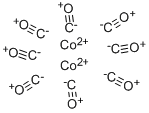
IdentificationPhysical DataSpectraRoute of Synthesis (ROS)Safety and HazardsOther Data
Identification
Product NameCOBALT CARBONYLMolecular StructureCAS Registry Number 10210-68-1MDL NumberMFCD00016024Molecular FormulaCo2(CO)8Molecular Weight341.95
Physical Data
AppearanceDark orange-red crystals
Spectra
No data available
Route of Synthesis (ROS)
Route of Synthesis (ROS) of Cobalt carbonyl CAS 10210-68-1
ConditionsYieldIn hexane byproducts: CO; The mixt. was stirred for 30 min at 20-25°C (N2 atm.);; evapd., sublimed, chromd. on silica gel with hexane-CH2Cl2;;80%
Safety and Hazards
No data available
Other Data
TransportationDark orange-red crystalsHS CodeStorageDark orange-red crystalsShelf Life1 yearMarket Price
DruglikenessLipinski rules componentMolecular Weight342.07HBA8HBD0Matching Lipinski Rules3Veber rules componentPolar Surface Area (PSA)0Rotatable Bond (RotB)1Matching Veber Rules2
Use PatternCOBALT CARBONYL CAS#: 10210-68-1 is an effective catalyst in organic synthesis, particularly in carbonylation reactions. It facilitates the reaction between carbon monoxide and organic compounds, leading to the formation of carbonyl-containing compounds. Such reactions are crucial in the synthesis of pharmaceuticals, fragrances, and other organic compounds. And it is also serve as a catalyst in polymer chemistry, participating in copolymerization reactions, for example, in copolymerization with olefins.
https://www.chemwhat.com/cobalt-carbonyl-cas-10210-68-1/
Comments
Post a Comment